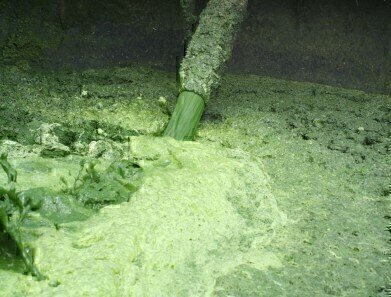Green Energy
Pumps Bring New Lease of Life to Mass of ‘Waste’ Tomato Leaves
Jul 10 2013
Tomato leaves definitely wouldn’t be your feedstock of choice for trying to generate headline figures of biogas, says Paul Davies from leading pump and mixer manufacturer, Landia (UK).
But, when you have some sixteen pallets (400kg per pallet) of tomato leaves to dispose of every day, then utilising the heat and electricity from them makes perfect sense – compared to what used to be a disposal cost of around £100,000 pa, not to mention a somewhat negative headline figure of sending two and half thousand tonnes of waste pa to landfill.
For the past five years, converting waste tomato leaves into a more than useful resource has been a labour of love for a major producer in the North West of England, who with Landia’s help, have been developing a highly innovative AD system.
“This is still primarily an R&D project”, says Davies, “and in some respects it always will be because you can never stop learning in this industry. Our customer hasn’t set out to simply try and squeeze as much electricity out of everything that they could. They are keen to pursue a truly self-sufficient, sustainable model, growing their own colony of bacteria to see how its full potential can be realised, rather than just looking for short term gain by adding materials that almost immediately guarantee gas, such as slurry, which isn’t favourable anyway at the location because of biosecurity issues”.
An R&D site, maybe, and a waste product that certainly isn’t the most conducive feedstock for high levels of biogas, but methane is already being successfully extracted and reused to produce considerable amounts of electricity and heat for the site’s extensive greenhouses. The company is also close to producing a valuable revenue stream in an enzyme-rich fertiliser that works well on grass, as well as an eco-fuel, with hopes to also use the CO2 produced during the AD process to enhance growth of the tomato plants.
Within the UK horticultural industry, the tomato growers were the pioneers of Combined Heat & Power (CHP), generating their own electricity and selling it back to the national grid to power the majority of the local village in an environmentally efficient way since 1998. Today, all of the heat produced is used on site, so there are no buying-in costs, nor climate levy payments to be made. Nothing is wasted because any heat that can’t be used immediately is stored as hot water in 600,000 litre insulated tanks for later use.
The masses of thick tomato leaves first have to be fed into a hopper, from where they are chopped by a macerator. Up to 40% dry matter, the leaves have a very thick consistency, so pre-treatment is vital. At this stage, a stainless steel 5.5 kW MPTKR chopper pump made by Landia is utilised to break down the organic plant material in a reception tank, otherwise its natural healing ability would make it go solid.
“Getting the leaves into the system in a way that you can get them to do what you want them to do has been the biggest challenge,” added Davies, who says that the grower has worked in conjunction with the University of York and the University of Central Lancashire to get to this stage.
He continued: “Our customer has wanted to try and understand what happens at the plant at different phases and times. This isn’t a typical sludge-like digestate you find at most anaerobic digestion systems where in some cases there seems to be a very non-scientific, ‘chuck everything in’ approach. And there was no wish to go down the route of the European biogas model, which does not fit the UK experience. Everyone has had to be extremely patient. Record-breaking gas yields are not going to happen here. However, this definitely isn’t going to be one of the increasing number of AD plants that are finding feedstock difficult or increasingly expensive to obtain”.
Gas produced from the plant currently provides around 10% of the energy needed for the 2.5MW operation (enough to power around 2,500 homes), equating to approximately 12m3 per tonne of tomato leaf.
After being physically reduced by the macerator, tomato leaf plant matter is then transferred to a buffer tank for 24 hours, where it is heated and also agitated by a 3kW DG Landia pump to enhance the enzyme-breakdown process. Careful fine tuning has gradually reduced this retention time from 14 days to just seven.
The vivid green liquid is then regularly transferred into a 4-tank batch loading system where solids are further reduced in digesters by small (just 0.75kW) Landia transfer pumps (one in each tank).
Paul Davies added: “We’ve tried to understand the aims of our customer as quickly as possible, which has resulted in our chopper pumps becoming a key part of optimising the process. Producing carbon neutral tomatoes has been a long haul but the tomato grower has significantly reduced its carbon footprint as a business and brought benefits to the environment and our local community. This is only really possible with proper joined up thinking and by providing equipment that is truly designed for purpose, with good back up”.
Events
IWA World Water Congress & Exhibition
Aug 11 2024 Toronto, Canada
Aug 25 2024 Stockholm, Sweden and online
Sep 03 2024 Mexico City, Mexico
Sep 03 2024 Mexico City, Mexico
Sep 03 2024 San Diego, CA, USA














